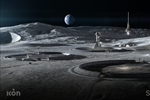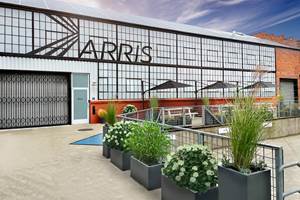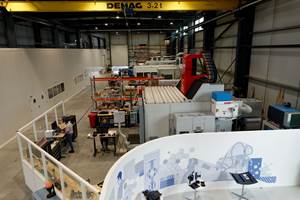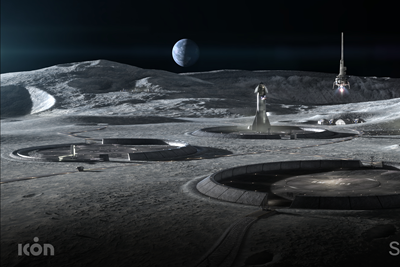Environmental testing completed for NASA James Webb telescope
Successful acoustic and sine-vibration testing ensures the composites-intensive space telescope will survive all of the harsh conditions associated with a rocket launch to space.

For the first time, testing teams at Northrop Grumman in Redondo Beach, California, carefully lifted the fully assembled James Webb Space Telescope in order to prepare it for transport to nearby acoustic and sine-vibration testing facilities. Photo Credit: NASA/Chris Gunn
With the completion of its latest series of milestone tests (including a successful tower extension test in June) NASA’s (Washington D.C., U.S.) James Webb Space Telescope (JWST) has now survived all of the harsh conditions associated with a rocket launch to space, including extensive acoustic and vibration testing. An international program led by NASA, along with its partners ESA (European Space Agency) and the Canadian Space Agency, the complex, composites-intensive space telescope was primarily designed to look for faint traces of infrared light coming from astronomical objects.
Webb’s recent tests have validated that the fully assembled observatory will endure the deafening noise, and the jarring shakes, rattles and vibrations that the observatory will experience during liftoff. Known as “acoustic” and “sine-vibration” testing, NASA says it has worked carefully with its international partners to match Webb’s testing environment precisely to what Webb will experience both on launch day, and when operating in orbit.
Though each component of the telescope has been rigorously tested during development, demonstrating that the assembled flight hardware is able to safely pass through a simulated launch environment is a significant achievement for the mission. Completed in two separate facilities within Northrop Grumman’s Space Park in Redondo Beach, California, these tests represent Webb’s final two, in a long series of environmental tests before Webb is shipped to French Guiana, South America, for launch.
“The successful completion of our observatory environmental tests represent a monumental milestone in the march to launch. Environmental testing demonstrates Webb’s ability to survive the rocket ride to space, which is the most violent portion of its trip to orbit approximately a million miles from earth. The multinational group of individuals responsible for the execution of the acoustic and vibration test is composed of an outstanding and dedicated group of folks who are typical of the entire Webb team,” says Bill Ochs, Webb project manager for NASA Goddard Space Flight Center in Greenbelt, Maryland.
Testing began by first encapsulating the entire telescope in a mobile clean room built to shield it from the outside world. Technicians then carefully guided it to a nearby acoustic testing chamber where it was intentionally blasted by sound pressure levels above 140 decibels, with a spectrum tuned to the specific signature of the Ariane 5 rocket it will ride to space. During the tests, nearly 600 individual channels of motion data were carefully observed and recorded. Typical acoustic and vibration tests measure approximately 100 channels of data, but the complex size and shape of the observatory required considerably more measurement to ensure success. The data was then thoroughly analyzed and marked as a complete success.
Upon successful completion of its final acoustics tests, Webb was again packed and transported to a separate facility to simulate the low frequency vibrations that occur during liftoff. While inside, Webb was placed on a specialized shaker table capable of precise vertical and horizontal acceleration. Where acoustic testing simulates the high-frequency dynamics of launch, vibration testing covers the lower frequencies experienced. With the combination of the two, the entire mechanical environment Webb will experience during launch is accounted for.
“The testing team is an international consortium of structural dynamics experts who are the lead engineers for each piece of hardware on the observatory. The team members are located throughout the U.S. and Europe, spanning across nine time zones! They are extremely dedicated to support testing at all hours and days to provide their expertise,” says Sandra Irish, Webb Mechanical Systems Structures engineer lead for NASA’s Goddard Space Flight Center in Greenbelt, Maryland.
Webb is now scheduled to move forward into the last full extension of its iconic primary mirror and sunshield followed by a full systems evaluation before being encapsulated in a specialized shipping container for transport to South America. Deploying the observatory after experiencing a simulated launch environment is the best way to replicate the true series of events the observatory will experience during launch, and when performing its complex deployment sequence in space. Initial analysis suggests the observatory passed through observatory level acoustic and vibration testing successfully, but the full verification of flight worthiness will occur after Webb has successfully completed final deployment tests.
According to NASA, its engineers and technicians continue to follow augmented personal safety procedures due to the COVID-19 situation, which is causing significant impact and disruption globally. The team has resumed near-full operations and are now preparing for the final phase of testing prior to shipment to the launch site.
NASA claims that JWST is the world’s largest, most powerful and complex space science telescope ever built. In addition to the groundbreaking science expected from it after launch, Webb has required an improvement in the testing infrastructure and processes involved in validating large complex spacecraft for a life in space. Various facilities around the country had to be enlarged and upgraded to confidently test and prepare a machine as large as Webb for liftoff. Lessons learned from previous space telescope development were invested into Webb, and future space telescopes will be built upon the same collective knowledge. Thousands of scientists, engineers, and technicians contributed to build, test and integrate Webb. In total, 258 companies, agencies and universities participated — 142 from the United States, 104 from 12 European nations and 12 from Canada.
Related Content
Recycling end-of-life composite parts: New methods, markets
From infrastructure solutions to consumer products, Polish recycler Anmet and Netherlands-based researchers are developing new methods for repurposing wind turbine blades and other composite parts.
Read MorePlant tour: Arris Composites, Berkeley, Calif., U.S.
The creator of Additive Molding is leveraging automation and thermoplastics to provide high-volume, high-quality, sustainable composites manufacturing services.
Read MoreRecycling hydrogen tanks to produce automotive structural components
Voith Composites and partners develop recycling solutions for hydrogen storage tanks and manufacturing methods to produce automotive parts from the recycled materials.
Read MorePlant tour: Daher Shap’in TechCenter and composites production plant, Saint-Aignan-de-Grandlieu, France
Co-located R&D and production advance OOA thermosets, thermoplastics, welding, recycling and digital technologies for faster processing and certification of lighter, more sustainable composites.
Read MoreRead Next
NASA looks to advance 3D printing construction systems for the Moon and Mars
Off-world construction is taken to a new level with NASA’s MMPACT project, which will test lunar soil simulant with various processing and printing technologies to determine 3D printing feasibility in space.
Read MoreVIDEO: High-volume processing for fiberglass components
Cannon Ergos, a company specializing in high-ton presses and equipment for composites fabrication and plastics processing, displayed automotive and industrial components at CAMX 2024.
Read More“Structured air” TPS safeguards composite structures
Powered by an 85% air/15% pure polyimide aerogel, Blueshift’s novel material system protects structures during transient thermal events from -200°C to beyond 2400°C for rockets, battery boxes and more.
Read More

























